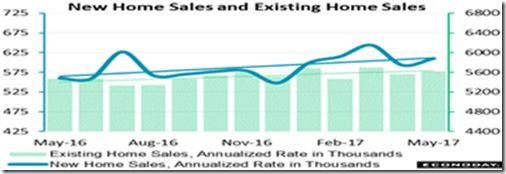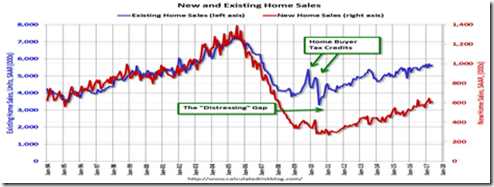The Mortgage Corner
It was very good news that new-home sales rose nearly 3 percent in May to a 610,000 annualized rate. The report, always volatile, included a big upward revision to April which however, at 593,000, is still the year’s low. But that isn’t close to the 1 million plus new homes built annually during the housing bubble.
Existing home sales also proved better than expected, up more than 1 percent to a 5.620 million rate. Low unemployment and low mortgage rates are major positives for housing. But that only exacerbates the shortage of homes on the market.
Graph: Econoday
And that doesn’t even take into account the 1 million prospective homebuyers who could buy a home, if Fannie and Freddie would ease their qualification standards to that which prevailed throughout the last 2 decades. But because the U.S. Treasury won’t release its stranglehold on supervision of the GSE’s, for fear that taxpayers might again be at risk if another housing bubble materializes, there is little prospect of this aid coming to first-time and entry-level buyers, in particular, that must then rely on the more expensive FHA alternative.
This is while the housing shortage continues, even though prices are up a median $252,800 for resales and $345,800 for new homes, a 6 percent rise, whereas household incomes are rising just 2.4 percent annually. The FHFA house price index is another of the week’s highlights, up sharply in April to a year-on-year rate of 6.8 percent.
This should boost housing construction, but housing starts are also lagging. And we are hardly in bubble territory. Bubbles occur when there is too much of something—whether housing, or credit—so that the resulting oversupply causes prices to plummet at they did during the Great Recession.
Calculated Risk shows the “Distressing Gap” that occurred with the housing crash, when oversupply of distressed housing caused new-home construction to plummet. It hasn’t yet recovered, but “in general the ratio has been trending down since the housing bust, and this ratio will probably continue to trend down over the next several years,” says Calculated Risk’s Bill McBride.
The National Association of Home Builders reported builder confidence in the market for newly-built single-family homes weakened slightly in June, down two points to a level of 67 from a downwardly revised May reading of 69 on the National Association of Home Builders/Wells Fargo Housing Market Index (HMI).
New-home inventories remain too low to satisfy surging demand that comes from low interest rates and full employment. Full employment is a two-edged sword, however, as it also means labor shortages and unfilled jobs. Where are those workers, when just 2 million are currently employed in construction, and there were as many as 6 million employed during the housing bubble? It could be the recession hangover, such as memories from the housing crash that has discouraged many from re-entering the workforce. Hence the 4 percent drop in labor participation rate since the end of the Great Recession.
“As the housing market strengthens and more buyers enter the market, builders continue to express their frustration over an ongoing shortage of skilled labor and buildable lots that is impeding stronger growth in the single-family sector,” said NAHB Chief Economist Robert Dietz.
Builders can’t keep up with the housing demand, in other words—especially now that the Millennials, those between the ages of 18 to 36, are coming into adulthood and outnumber all other population groups. A good percentage will want to own a home someday as their primary asset.
The younger baby boom generation dominated in 2010. By 2016 the millennials have taken over. “The six largest groups, by age, are in their 20s – and eight of the top ten are in their 20s,” reports Bill McBride and the U.S. Census Bureau.
Harlan Green © 2017
Follow Harlan Green on Twitter: https://twitter.com/HarlanGreen


